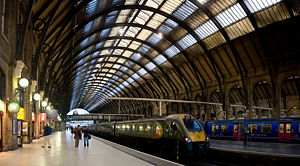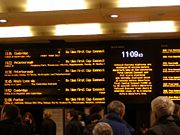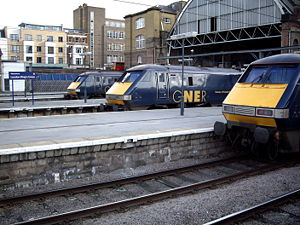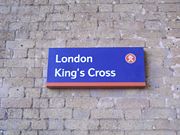London King's Cross railway station
 The view from platform 8 of King's Cross station on 1 September 2007 |
|
| Location | Kings Cross |
|---|---|
| Local authority | Camden |
| Managed by | Network Rail |
| Station code | KGX |
| Platforms in use | 11 |
| Travelcard zone | 1 |
| NR 2004/5 usage | 20.806 million[1] |
| NR 2005/6 usage | 20.302 million[1] |
| NR 2006/7 usage | 22.504 million[1] |
|
|
|
| 1852 | Opened |
|
|
|
| List of stations | Underground • National Rail |
| External links | Departures • Facilities |
|
|
|
King's Cross station is a major railway terminus opened in 1852. The station is located on the edge of Central London, on junction of the A501 Euston Road and York Way, in the King's Cross district and within the London Borough of Camden on the border of the London Borough of Islington.
King's Cross forms the southern terminus of the East Coast Main Line, one of the UK's major railway backbones. Immediately to the west is St Pancras station, the terminus for international Eurostar trains, and the two stations share King's Cross St. Pancras tube station on the London Underground network.
Contents |
Location and surroundings
West of King's Cross are, in succession, St Pancras station, the new British Library building and Euston station, all within a few minutes' walk.
The reconstructed and restored St Pancras is the new London terminus of High Speed 1[2] replacing Waterloo International from 14 November 2007. Eurostar trains serve Lille Europe, Paris Gare du Nord and Brussels Midi-Zuid, and from 2009 domestic SouthEastern services will serve Kent over the High Speed 1 route.
Considerable regeneration effort has gone into the area in recent years, with the opening of new hotels and office space under construction.
Services
The station is served by routes from the north and east of England and Scotland, connecting to major cities such as Cambridge, Peterborough, Hull, Doncaster, Leeds, York, Newcastle, Edinburgh, Glasgow, Dundee, Aberdeen and Inverness.
Four train companies currently run services into the mainline station:
- National Express East Coast: inter-city services on the East Coast Main Line to Peterborough, Doncaster, Leeds, Wakefield, York, Darlington, Durham, Newcastle Central, Edinburgh Waverley, Glasgow Central , Dundee, Aberdeen and Inverness. National Express East Coast also has plans to operate a new service to Lincoln Central from 2010. National Express East Coast are known as the "lead operators" from the station.

- First Capital Connect: suburban and regional services to North London, Hertfordshire, Bedfordshire and Cambridgeshire.
- First Hull Trains: inter-city services to Hull via the East Coast Main Line. Unlike its sister company, First Hull Trains is not a franchised train operating company but operates under an "open access" arrangement.
- Grand Central: inter-city services to north-east Yorkshire and Sunderland, also along the East Coast Main Line. Grand Central is also an "open access" operator.
| Preceding station | National Rail | Following station | ||
|---|---|---|---|---|
| Terminus | First Hull Trains East Coast Main Line |
Stevenage | ||
| First Hull Trains East Coast Main Line |
Grantham | |||
| Terminus | National Express East Coast East Coast Main Line |
Stevenage, Peterborough, Doncaster, Wakefield or York |
||
| Terminus | Grand Central London-Sunderland |
York | ||
| Terminus | First Capital Connect Great Northern |
Finsbury Park
or St. Neots |
||
| Terminus | First Capital Connect Cambridge Cruiser |
Cambridge | ||
History

King's Cross was originally designed and built as the London hub of the Great Northern Railway and terminus of the East Coast Main Line. It was designed by Lewis Cubitt and constructed in two years from 1851 to 1852, on the site of a former fever and smallpox hospital. The main part of the station, which today includes platforms 1 to 8, was opened on 14 October 1852. It replaced a temporary terminus at Maiden Lane that had opened on 8 August 1850.
The platforms have been reconfigured several times; originally there was only one arrival and one departure platform (today's platforms 1 and 8 respectively), with the space between used for carriage sidings. In later years as suburban traffic grew, space for additional platforms was added with considerably less grandeur; the secondary building now containing platforms 9–11, (which would include the fictional Platform 9 3/4), survives from that era.
When the railways were privatised in 1996, express services into the station were taken over by GNER; though they successfully re-bid for the franchise in 2005, they were asked to surrender it in December 2006. The incumbent operator, National Express East Coast, took over the franchise on 9 December 2007, after an interim period when GNER ran trains under a management contract.
According to legend, King's Cross is built on the site of Boudica's final battle, or else her body is buried under one of the platforms. Platforms 8, 9 and 10 have been suggested as possible sites. There are also passages under the station which Boudica's ghost is supposed to haunt.
The King's Cross fire of 1987, in which 31 people died, was at the adjacent King's Cross St. Pancras Underground station. A major redevelopment of this Underground station (partly influenced by the report issued after the fire) is currently in process. Phase One was completed in 2006; Phase Two is expected to be complete by 2011.

The original "King's Cross" was a monument to King George IV.
In 1972, a one-storey extension designed in-house by British Rail was constructed in front of the station. While the extension was intended to be temporary, more than thirty years later it still stands. Many consider the extension unattractive, not the least because it obscures the Grade I-listed façade of the original station. Prior to the construction of the extension, the station façade had already become hidden behind a small terrace of shops. This extension is scheduled to be demolished, revealing once again the full glory of the Lewis Cubitt architecture, when a new ticket hall and concourse area is built on the station's western side.
On 10 September 1973, a Provisional IRA bomb exploded in the booking hall at 12.24 pm, causing extensive damage and injuring six people, some seriously. The 3 lb (1.4 kg) device was thrown without warning into the station by a youth who escaped into the crowd and was not apprehended.[3]
In days gone by, part of King's Cross was an intermediate station. On the extreme east of the site was Kings Cross York Road, with suburban trains travelling south from Finsbury Park calling here, then going underground using the York Road curve to join the City Widened Lines to Farringdon, Barbican and Moorgate. In the other direction, trains from Moorgate came off the Widened Lines via the Hotel Curve, with platform 16 rising to the main line level. Services to and from Moorgate were diverted via the Northern City Line from August 1976.
Restoration

In 2005, a £400 million restoration plan was announced by Network Rail, which was approved by the Camden Council on 9 November 2007.[4] Planned is a thorough restoration of the arched roof of the station and the demolition of the 1972 addition, to be replaced by an open-air plaza. A semi-circular concourse (estimated completion date 2012) will be built in the space directly to the west of the station behind the Great Northern Hotel, which will have some outbuildings demolished. It will replace the current 1972 concourse, shopping area and National Express East Coast ticket office, providing greater integration between the intercity and suburban sections of the station, as well as easier access to St Pancras. The land between and behind the domestic main lines leading from the two stations is being redeveloped with nearly 2,000 new homes, 486,280 m2 (5,234,000 sq ft) of offices and new roads as King's Cross Central.
The redevelopment is controversial and has resulted in a local campaign being set up to press for improved access in the new design.
King's Cross St. Pancras tube station
King's Cross St. Pancras tube station is served by more lines than any other station on the London Underground, and is therefore one of the busiest, serving both King's Cross and St Pancras main line stations. It is in Travelcard Zone 1.
Major work is ongoing at the station to link the various entrances to two new ticket halls for London Underground and reduce overcrowding. Overcrowding has led to the closure of the entry and exit to the main Tube Ticket Hall from inside King's Cross during the weekday morning peak rush hours. Passengers needing to access King's Cross St. Pancras tube station must do so via the new entrance outside King's Cross. Staff are placed at this entrance throughout the morning peak to implement "Crowd Control" and narrow or close the entrance. This entrance is used as none of the other entrances to King's Cross St. Pancras tube station can be closed, either being inside St. Pancras or are too close to the Euston Road to allow room for large crowds to wait.
| Preceding station | Following station | |||
|---|---|---|---|---|
|
Euston Square
towards High Street Kensington
|
Circle line |
Farringdon
towards Liverpool Street
|
||
|
Euston Square
towards Hammersmith
|
Hammersmith & City line |
Farringdon
towards Barking
|
||
|
Euston Square
towards Uxbridge, Amersham,
Chesham or Watford |
Metropolitan line |
Farringdon
towards Baker Street or Aldgate
|
||
|
Euston
towards Edgware, Mill Hill East
or High Barnet |
Northern line |
Angel
towards Morden
|
||
|
Russell Square
towards Uxbridge or
Heathrow (Terminals 1, 2, 3 or Terminal 5) |
Piccadilly line |
Caledonian Road
towards Cockfosters
|
||
|
Euston
towards Brixton
|
Victoria line |
Highbury & Islington
towards Walthamstow Central
|
King's Cross in fiction
Pet Shop Boys
In their hit music videos West End Girls (1985) and Rent (1987), Kings Cross Station is used extensively as a backdrop. In West End Girls they are seen walking around the concourse while the song plays in the background and in Rent, the same concourse is used as a meeting point for Chris Lowe and Margi Clarke playing characters who are reunited, in front of the departures / arrivals board. Also in the background are notices stating that engineering work will disrupt services, which at the time, 1987, was actually in progress to modernise the line. It is not known if the station was closed for filming, and it doesn't look like it was at all. Parked outside in the taxi rank of the station is Neil Tennant, who is playing Margi Clarke's taxi driver in the same music video.
The station was also extensively filmed in for the Pet Shop Boys feature film, released in 1988, It Couldn't Happen Here.
Harry Potter
King's Cross is featured in the Harry Potter books, by J. K. Rowling, as the starting point of the Hogwarts Express. The train uses a secret platform 9¾ located by passing through the brick wall barrier between platforms 9 and 10.
Unfortunately, platforms 9 and 10 are in a separate building from the main station; also, rather than being adjacent so that a barrier could be between them, they are separated by two intervening tracks. Rowling intended the location to be in the main part of the station, but misremembered the platform numbering. During an interview in 2001, she indicated that she had confused King's Cross with Euston. In fact, platforms 9 and 10 at Euston are also separated by two intervening tracks.
When the movies were filmed, the station scenes took place within the main station, with platforms 4 and 5 renumbered 9 and 10. In the film of Harry Potter and the Chamber of Secrets, the exterior of the adjacent St. Pancras station was used, as its Gothic façade was considered more impressive than the real King's Cross station.
When the first film was released, a large floor panel was placed on the ground outside platforms 9 and 10 indicating the Hogwarts Express. It was later removed. Within King's Cross, a cast-iron "Platform 9¾" sign has been erected on a wall of the station's suburban building containing the real platforms 9 and 10. Part of a luggage trolley has also been installed below the sign; whilst the near end is visible, the rest of the trolley seems to have disappeared into the wall.
"Kings Cross" is the title of the 35th chapter of Harry Potter and the Deathly Hallows, where a location resembling the station plays a significant role. The station is also featured in the epilogue of the same book, making it the final setting of the Harry Potter series.
Other fiction
- King's Cross is the title of a song written by English music duo Pet Shop Boys. The song was released in their 1986 album, Actually. Never released as a single, it's however a fave of most fans and Pet Shop Boys have performed it live. In 2007 Tracey Thorn did a cover of the song and got it remixed by Hot Chip.
- The station is mentioned as suggesting "infinity" to Margaret Schlegel and contrasted with the "facile splendours" of St Pancras in Chapter 2 of E.M. Forster's novel Howard's End.
- The Doctor Who Virgin New Adventures novel Transit features King's Cross as one of the main hubs of an interplanetary transit system based on the London Underground.
- In children's television programmes featuring the puppet Roland Rat, Roland is said to live in the sewers beneath King's Cross. In Roland Rat: The Series this was realised as the high-tech "Ratcave", accessed from a hidden lift in a workman's shelter.
- The twelfth and final episode of the anime Victorian Romance Emma prominently features King's Cross Station in 1885 with great historical accuracy and detail.
- Some of Arthur Conan Doyle's Sherlock Holmes stories have the great detective and Dr Watson travelling by way of King's Cross. The following example is from The Adventure of the Missing Three-Quarter, Watson speaking first:
"And what have you gained?"
"A starting-point for our investigation." He hailed a cab. "King's Cross Station," said he.
"We have a journey, then?"
"Yes; I think we must run down to Cambridge together. All the indications seem to me to point in that direction."
- The station, its surrounding streets and the railway approach feature prominently in scenes from the 1955 Ealing comedy, The Ladykillers.
- Scenes from the 1995 Bollywood film Dilwale Dulhania Le Jayenge (DDLJ) were filmed at this station.
- There is an underground station called King's Cross on the North London System in the 1980 novel The Horn of Mortal Danger. It corresponds to this station rather than the Tube one.
- In the Rev. W.V. Awdry's Railway Series of children's books, Gordon, Duck and an engine from "the Other Railway" have a lengthy argument about the name of the London station (King's Cross Paddington or Euston), apparently not realizing that there is more than one railway station in London.
- In Eva Ibbotson's children's book The Secret of Platform 13, there is a door between worlds called a "Gump" under the fictitious and abandoned platform 13.
- R.S.V.P. Part 1, an issue of the comic book Hellblazer begins with a shot of the Platform 9¾ sign; appropriate, because the story itself concerns a gathering of magicians—albeit a less palatable one than Hogwarts.
- In the film Green Street,[5] King's Cross station can be seen in the background of its now abandoned car park.
- In the 1933 film Friday the Thirteenth, King's Cross is used as the location to introduce two of the main characters. The name of the station is emphasised in the dialogue.
Spelling

The station name, King's Cross, is seen spelt both with and without an apostrophe:
- King's Cross is the signage used in the Network Rail and London Underground stations and on the tube map.
- The official Network Rail webpage uses the "King's Cross" spelling.[6]
- Kings Cross is used in the National Rail timetable database, as well as on other National Rail railway pages, and the usage is also seen on the TheTrainLine online booking system. However, other stations such as King's Lynn and Hall i' th' Wood also lack apostrophes, suggesting that this is a software limitation.
- Kings X or London KX are abbreviations seen in space-limited contexts.
- KGX is used as the station code
Footnotes and References
- ↑ 1.0 1.1 1.2 Annual passenger usage based on sales of tickets in stated financial year(s) which end or originate at London King's Cross railway station from Office of Rail Regulation statistics
- ↑ High Speed 1 is the high-speed railway linking London with the Channel Tunnel. It was formerly known as the Channel Tunnel Rail Link (CTRL).
- ↑ "1973: Bomb blasts rock central London", On this Day - 10 September, bbc.co.uk. Retrieved on 2007-02-27.
- ↑ "Planning Application - 2006/3387/P". Camden Council Planning Applications. London Borough of Camden. Retrieved on 2008-06-19.
- ↑ Green Street was released as Green Street Hooligans in the US and Australia; it was called Football Hooligans or Hooligans elsewhere.
- ↑ Station information on King's Cross railway station from Network Rail
External links
- King's Cross Central developer
- King's Cross Development Forum, a group facilitating the community response to the King's Cross Central development
- The King's Cross community website
- King's Cross Railway Lands Group
|
|||||||||||